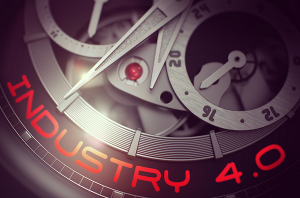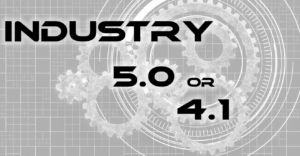The commercial world is being roiled by new technologies. Old business models are being replaced by new ones and essential information technologies seem to have shorter lifespans than most small animals. One concept gaining traction in this changing business climate is Industry 4.0 — the label given to emerging “smart” factories ushering in the Fourth Industrial Revolution. Industry 4.0 is the coming together of numerous technologies such as the Internet of Things (IoT), cognitive computing, digitalization, and additive manufacturing (aka 3D printing). Tim Sandle (@timsandle) asks, “Does the Internet of things, artificial intelligence, networked production, and so on mean that industry is on the precipice of a new era?”[1] He reports the Karlsruhe Institute of Technology answers that question in the affirmative and asserts “it’s time for companies to accept this.” Moreover, respondents in a survey conducted by the Institute concluded “companies will fail if they refuse digitization.”
Defining Industry 4.0 and Its Challenges
Sandle writes, “Industry 4.0 is, like many phrases, a label. It is intended to convey how industry first became mechanized (Industry 1.0); then introduced the techniques of mass production (Industry 2.0); and next took on the computer (Industry 3.0).” What does the label represent? According to Sandle, “Where Industry 4.0 comes in is with the current trajectory of automation and data exchange in manufacturing technologies. In other words such developments as cyber-physical systems, the Internet of things, cloud computing and cognitive computing. Add to this big data analytics, virtual reality and edge computing. For industry this means establishing the so-termed ‘smart factory’. Here cyber-physical systems will monitor physical processes and make decentralized decisions. Via the Internet of Things, systems will communicate and cooperate with each other, as well as and with people in real time.” Analysts from Fliptin add, “Industry 4.0 is coming fast and to compete in tomorrow’s world, and beyond, tech companies must evolve with the times.”[2] They then ask two questions: “Are you ready for Industry 4.0? And what challenges will you face in the near future?” To help answer the first question, they answer the second one (i.e., what challenges does Industry 4.0 present?). The challenges include:
- New business models — the definition of a new strategy
- Rethinking your organization and processes to maximize new outcomes
- Understanding your business case
- Conducting successful pilots
- Helping your organization to understand where action is needed
- Change management, something that is too often overlooked
- Examination of company culture
- The genuine interconnection of all departments
- Recruiting and developing new talent
Obviously, a lot of groundwork needs to be done before an organization can start transforming itself in to a digital enterprise (or building a smart factory).
Moving towards Industry 4.0
There isn’t a single blueprint (i.e., no one-size-fits-all model) organizations can use to transform into an enterprises suitable for the digital age and Industry 4.0 operations. Nevertheless, there are a few general principles that can be followed.
Identify Goals and Generate Strategies
If you don’t know where you are going, you’ll never get there. The conversation Alice had with the Cheshire Cat in Lewis Carroll’s Alice in Wonderland sums up this principle pretty well:
“Would you tell me, please, which way I ought to go from here?”
“That depends a good deal on where you want to get to,” said the Cat.
“I don’t much care where—” said Alice.
“Then it doesn’t matter which way you go,” said the Cat.
“—so long as I get SOMEWHERE,” Alice added as an explanation.
“Oh, you’re sure to do that,” said the Cat, “if you only walk long enough.”
Organizations won’t succeed if they just want to go “somewhere.” They need to identify specific goals and then generate strategies that will help them achieve those goals. Sandle writes, “First, identify promising applications and break this down into easier-to-handle packages. This involves looking at areas of production and products in a stepwise manner.” If you are not sure where to begin, Aurimas Bakas, chairman of DocLogix, recommends beginning with setting goals to improve processes. “Companies should take an end-to-end look at their existing processes and look to increase collaboration, as well as simplify how the company functions wherever possible. Automation and information-related processes are a key part of the smart factory.”[3] Bakas warns, however, “[Companies] shouldn’t replicate and automate bad business processes.” As Bill Gates (@BillGates) once noted, “The first rule of any technology used in a business is that automation applied to an efficient operation will magnify the efficiency. The second is that automation applied to an inefficient operation will magnify the inefficiency.”
Prototype and Simulate
François Barbier (@franzbarbier), President of Global Operations and Components at Flex, observes, “New tools are allowing companies to create and test situations in the virtual world and to simulate the design process and the assembly line before an actual product is created. Simulating the product-creation phase helps cut down on manufacturing time and ensure the manufacturing process delivers what companies intended to create.”[4] At Enterra Solutions® we recommend a crawl, walk, run approach to prototyping. This approach allows a solution to be tweaked before it is scaled. Adam Mussomeli, Aaron Parrott, and Lane Warshaw, from Deloitte Consulting, note that digitalization now provides companies with new opportunities. “Thanks to continuous streams of real-time data, it’s now possible to create a digital twin of virtually any product or process, enabling manufacturers to detect physical issues sooner, predict outcomes more accurately, and build better products.”[5]
Leverage Human/Machine Collaboration
Data and analytics play an important role in almost every step of digital transformation. For that reason, Sandle asserts companies must “analyze data processing, company-wide networking of production, and human-machine interaction.” Although there is a lot of discussion about artificial intelligence and robotics taking over the workplace from humans, many analysts believe the future will be characterized by human/machine collaboration. Jeff Schwartz (@JL_Schwartz), a Principal at Deloitte Consulting, argues, “As artificial intelligence, robotics, and cognitive tools grow in sophistication, almost every job is being reinvented, creating what many call the augmented workforce. Today this trend is gathering speed, causing many organizations to reconsider how they design jobs, organize work, and plan for future growth.”[6]
Establish a Digital Ecosystem
Whether you are talking about Industry 4.0 or the Internet of Things, what is really involved is a digital ecosystem consisting of sensors, connectivity, and advanced analytics. For that reason, Sandle insists companies must “consider the integration of sensors for data acquisition and IT services for data processing.” Cognitive computing platforms are ideal for the Industry 4.0 environment because they can collect, integrate, and analyze both structured and unstructured data. They can be programmed to carry out autonomous operations, make autonomous decisions, and provide actionable insights to business executives. The more robust the digital ecosystem, the more resilient the organization is likely to be.
Summary
If analysts from the Karlsruhe Institute of Technology are correct about the inevitability of Industry 4.0, then enterprises can’t afford to delay their digital transformation. Analysts from Fliptin list some of the key benefits of the new industrial revolution. They are:
- Enhanced productivity through optimization and automation
- Real-time data for real-time supply chains in a real-time economy
- Greater business continuity through advanced maintenance and monitoring possibilities
- Higher quality products as a result of real-time monitoring, IoT-enabled quality improvement and cobots
- Better working conditions and superior sustainability
- Personalization opportunities that will earn the trust and loyalty the modern consumer
If your company hasn’t started moving towards Industry 4.0, the time to start is now.
Footnotes
[1] Tim Sandle, “New recommendations for implementing industry 4. 0,” Digital Journal, 30 July 2017.
[2] Editor, “The Challenges of Industry 4.0,” Fliptin, 2 May 2017.
[3] Gary Hilson, “7 Steps that Move Manufacturers to Industry 4.0,” EBN, 27 April 2017.
[4] François Barbier, “5 Trends for the Future of Manufacturing,” Longitudes, 5 July 2017.
[5] Adam Mussomeli, Aaron Parrott, and Lane Warshaw, “Meet Manufacturing’s Digital Twin,” The Wall Street Journal, 9 August 2017.
[6] Jeff Schwartz, “Get Ready for the Augmented Workforce,” The Wall Street Journal, 10 May 2017.





